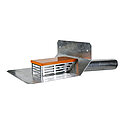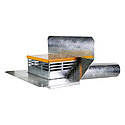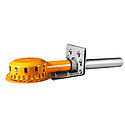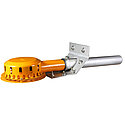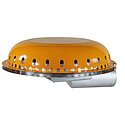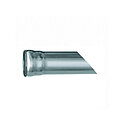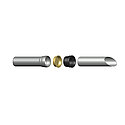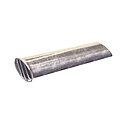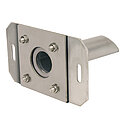LORO-X Spout
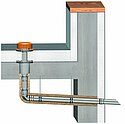
Performance comparison
1x LORO-X ATTIKASTAR DN100 as complete system discharges 32 liter per second at a water height of 75 mm on the roof with a weir height of 60 mm (congestion element).
In order to achieve the same discharge rate with conventional spouts, 106x DN100 round spouts have to be installed at a height of 60 mm. At a congestion of 15 mm, these spouts achieve a discharge of 0.3 liter per second at a water height of 75 mm on the roof.
*Source: specification sheet LX766.
LORO-X Spouts according to roof drainage standards
Also spout solutions without downpipe should reach the minimum runoff coefficients: How can I be on the safe side?
The increasing number of heavy rain incidents demands a safe emergency drainage into the open.
Due to their high performance, often modern siphonic flow systems via the parapet with specification sheet as proof of performance are used for the emergency drainage into the open. That way the number of required drains and parapet recesses is reduced significantly.
However, it is also possible that a downpipe cannot or shall not be installed. In that case efficient spouts are required!
Different discharge capacities for one drain?
Spouts without downpipe are not able to develop an efficient siphonic flow.
In the case of a so-called “overloaded gravity flow” and “siphonic flow” the accelerating effect of the downpipe does not exist. This leads to a lower discharge rate.
The test setups for parapet drains that are described in the current DIN EN 1253 standard allow a test with or without downpipe for the determination of the discharge capacity.
That is why leading producers indicate at least two discharge rates for parapet emergency drains: on the one hand the discharge capacity with downpipe and on the other hand the discharge capacity without downpipe as spout.
The current DIN 1986-100 demands explicit minimum runoff coefficients for emergency drains with gravity flow for the case of a water congestion of 35 mm above the overflow edge. The height of the overflow edge for emergency drains can vary depending on the usage of an integrated weir or a higher installation of the whole drain.
Usually, a weir height of 40 mm is used for the main drainage with gravity flow and a 60 mm weir height for the main drainage with siphonic flow.
For safety reasons: minimum runoff coefficients also for spouts!
In order to meet the minimum runoff coefficients required by the DIN standard also for the spout version, a special construction form of the drain which increases the discharge rate has to be used.
The majority of parapet drains in DN 100 that are available on the market only reach the minimum discharge rate of 4.5 liter per second at an overflow of 35 mm in combination with a special test setup with downpipe.
In the case of installing the drain at the building without downpipe, the runoff coefficients that have been determined in this test setup cannot be reached anymore.
On the basis of three application examples the capability of different spout solutions shall be contrasted.
In order to guarantee objective comparability, the following conditions are true for all three examples: the simple pipe DN 100 is installed at a height of 60 mm and the weir is adjusted to a height of 60 mm for every parapet drain. (All required weir heights between 25 and 60 mm can be realized with LORO.)
Conclusion: This is how you are on the safe side
If spouts with gravity flow are used for the emergency drainage of flat roofs, lower discharge rates than required by the roof drainage standard DIN 1986-100 and EN 1253 can be the case.
Spouts without downpipe constitute a special installation situation of parapet drains. A lower discharge rate than determined in the DIN standard test setup for this drain can be the consequence
Due to the fact that the manufacturer specifications – for promotional reasons – usually indicate the discharge rate with downpipe, the capability as spout without downpipe is often insufficiently verified.
If parapet drains as spout are used, it is important to pay close attention to the manufacturer specifications “without downpipe” and to compare the indicated figure with the minimum runoff coefficients of DIN 1986-100.
Only trust explicit proof of performance such as the LX-specification sheets of the roof drainage specialist LORO.
